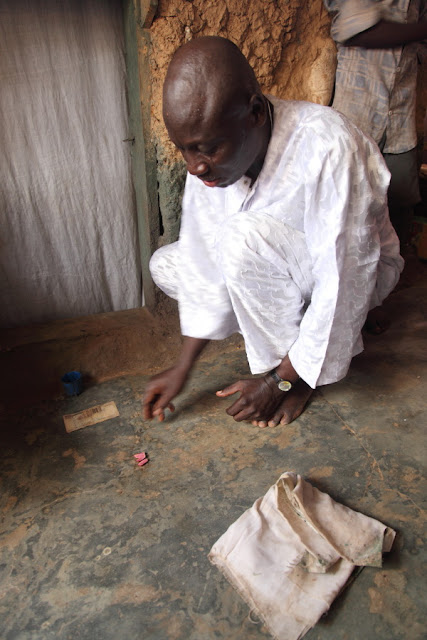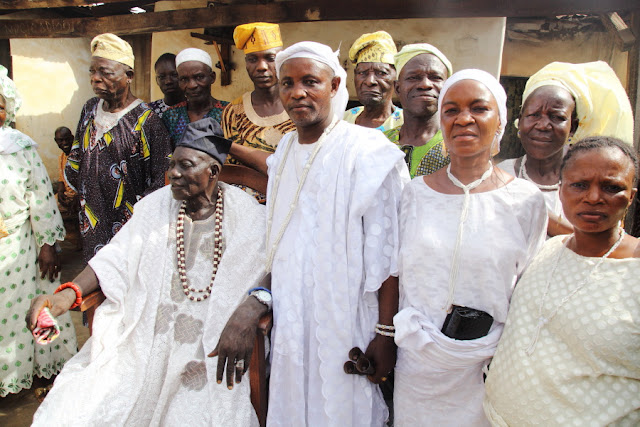 |
| with Chief schnapps, it is easier to communicate with the spirits |
Oyo, the city where the
Alaafin is residing, is hosting many compounds dedicated to the gods of the Yoruba religion. A number of families are residing inside the compound under the authority of an elder and priest called Baba. Somewhere in the compound is a shrine dedicated to a particular yoruba deity. These days the ancient religion of the Yorubas is in a complex situation. Islam and Christianity have become the mainstream religions which have made significant inroads in the population while the ancient cult of the Yorubas is being worshipped discretely by a minority of people. A few years back being an official worshipper could get you excluded from attending school, says Paula the cultural attache to the Alaafin, but this is gradually changing. Obviously monotheist cults are incompatible with ancient religions but in practice many muslims and christians will somehow have a form of relationship with the ancient cult because of juju or voodoo. Also every family is worshipping its ancestors in the form or spirits (egungun) every year.
The compound of Sango
In its center, surrounded by a number of traditional houses made of mud-bricks and corrugated iron roofs, is a large mud building that cannot be visited by any one except the priests of Sango and the King during the first day of the crowning ceremony, where he will swap roles with the high priest of Sango and leave the Sango shrine as King without being allowed to see the Sango high-priest again. The center of the shrine has trees which can be seen from outside. It looks like a little oasis in the area where the ground is made of red earth. The front wall of the shrine is painted red and has white stripes as well as a few symbols painted over it.
 |
| the high priest of Sango in front of the shrine's door |
The compound of Obatala
 |
| Baba Adisa reading the message from the Kola nut |
we stopped in another compound where Baba Adisa, a priest of Obatala the divinity of pureness, made an offering with a kola nut. Before the offering, every person wanted to be included in the blessing would have to be touched on the forehead with the kola nut. Then some money would be put on the floor next to the kola nut and the priest would spray them with water and shake a small bell, recite some prayers before reading the message of the kola nut that would then be cut in small pieces and spread among the onlookers to eat. Kola nut tastes very bitter.
The compound of Oduduwa
The compound of Baba Iyaji is dedicated to Oduduwa. He is the Baba of the 6th generation. We entered the compound in a vast courtyard with few fully grown trees providing shade to the participants of an upcoming procession. One of them had its trunk surrounded by a wall of roughly 1.2m high that was serving as a shelter to a crocodile, allegedly 30 or 40 years old. The crocodile was sleeping as we came but was soon to be awoken by a man who poked it with a metal bar.
Baba Iyaji gave an audience in a inner courtyard where he sat on a tired wooden throne in the shade of a roof. the side of the courtyard had banks for elders and guests to sit around.
The whole extended family was gathered, some drummers were summoned and the wives of Baba Iyaji came to salute the old man bowing down in front of him. One of them rolled from side to side. The other wives were dancing together. Speeches were made to welcome the guests. We then had a look at the graves of the 6th ancestors of Baba Iyagi buried all -around the inner courtyard in covered passage-way. A white calabash, whitened was put in each of the niches above the graves. Some objects belonging to the ancestors were included in the wall above the entrance of the niche, like bowls of porcelain.
 |
| Baba Iyaji (seated) and his entourage |




Comments
Post a Comment